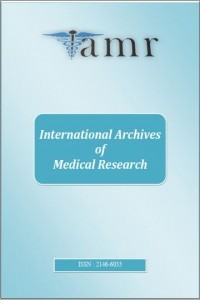The Role of Growth Hormone in Regulation and Secretion of Ghrelin
The Role of Growth Hormone in Regulation and Secretion of Ghrelin
Ghrelin, growth hormon, food intake,
___
- Kojima M, Hosoda H, Date Y, Nakazato M, Matsuo H and Kangawa K. (1999) Ghrelin is a novel growth hormone releasing acylated peptide from stomach. Nature, 402: 656-660.
- Date Y, Toshinai K, Koda S, et al. (2005) Peripheral interaction of ghrelin with cholecystokinin on feeding regulation. Endocrinology, 146: 3518-3525.
- Toshinai K, Yamaguchi H, Sun Y, et al. (2006) Des-acyl Ghrelin induces food intake by a mechanism independent of the growth hormone secretagogue receptor. Endocrinology, 147: 2306-2314.
- Sandstrom 0, Mahdavi J and El-Salhy M. (1999) Age-related changes in antral endocrine cells in mice. Histol Histopathol, 14: 31-36.
- Rigamonti AE, Pincelli AI, Corra B, et al. (2002) Plasma ghrelin concentrations in elderly subjects: comparison with anorexic and obese patients. J Endocrinol, 175: R1-R5.
- Broglio F, Benso A, Castiglioni C, et al. (2003) The endocrine response to ghrelin as a function of gender in humans in young and elderly subjects. J Clin Endocrinol Metab, 88: 1537-1542.
- Englander EW, Gomez GA and Greeley Jr GH. (2004) Alterations in stomach ghrelin production and in ghrelin- induced growth hormone secretion in the age rats. Meek Ageing Dev, 125: 871-875.
- Anawalt BD and Merriam GR. (2001) Neuroendocrine aging in men. Andropause and somatopause. Endocrinol Metab Clin North Am, 30: 647-649.
- Lamberts SWJ, van den Beld AW and van den Lely AJ. (1997) The endocrinology of aging. Science, 278: 419-424.
- Macintosh C, Moorley JE and Chapman IM. (2000) The anorexia of aging. Nutrition, 16: 983-995.
- Morley JE. (2001) Decreased food intake with aging. J Gerontol A Biol Sci Med Sci, 56: 81-88.
- .Morley E. and Thomas DR. (1999) Anorexia and aging: pathophysiology. Nutrition, 15: 499-503.
- Morley JE. (2001) Anorexia, sarcopenia, and aging. Nutrition, 17: 660-663.
- Baumgartner RN, Koehler KM, Gallagher D, et al. (1998) Epidemiology of sarcopenia among the elderly in New Mexico. Am J Epidemiol, 147: 755-763.
- Sullivan DH. (1998) The role of nutrition in increased morbidity and mortality. Clin Geriatr Med, 11: 661-674.
- Asakawa A, Inui A, Kaga T, et al. (2001) Ghrelin is an appetite-stimulatory signal from stomach with structural resemblance to motilin. Gastroenterology, 120: 337-345.
- Lawrence CB, Snape AC, Baudoin FM and Luckman SM. (2002) Acute central ghrelin and GH secretagogues induce feeding and activate brain appetite centers. Endocrinology, 143: 155-162.
- Nakazato M, Murakami N, Date Y, et al. (2001) A role for ghrelin in the central regulation of feeding. Nature, 409: 194-198.
- Wren AM, Small CJ, Abbott CR, et al. (2001) Ghrelin causes hyperphagia and obesity in rats. Diabetes, 50: 2540- 2547.
- Hallfrisch J, Muller D, Drinkwater D, Tobin J. and Andres R. (1990) Continuing diet trends in men: the Baltimore Longitudinal Study of Aging (1961-1987). J Gerontol, 45: 186-191.
- Koehler KM. (1994) The New Mexico Aging Process Study. Nutr Rev, 8: 34.
- Macintosh CG, Morley JE, Wishart J, et al. (2001) Effect of exogenous cholecystokinin (CCK)-8 on food intake and plasma CCK and insulin concentrations in older and young adults: evidence for increased CCK activity as a cause of the anorexia of aging. J Clin Endocrinol Metab. 86: 5830-5837.
- Baixeras E, Jeay S, Kelly PA and Postel-Vinay MC. (2001) The proliferative and antiapoptotic actions of growth hormone and insulin-like growth factor-1 are mediated through distinct signaling pathways in the Pro-B Ba/F3 cell line. Endocrinology, 142: 2968-2977.
- Ho KY, Evans WS, Blizzard RM, et al. (1987) Effects of sex and age on the 24 h profile of growth hormone secretion in man: importance of endogenous estradiol concentrations. J Clin Endocrinol Metab, 64: 51-58.
- Minisola S, Pacitti MT, Scarda A, et al (1993) Serum ionized calcium, parathyroid hormone and related variables: effect of age and sex. Bone Miner, 23: 183-193.
- Aloi JA, Gertz BJ, Hartman ML, et al. (1994) Neuroendocrine responses to a novel growth hormone secretagogue, L-692, 429, in healthy older subjects, J Clin Endocrinol Metab, 79: 943-949.
- Chapman IM, Bach MA, Van Cauter E, et al. (1996) Stimulation of the growth hormone (GH)-insulin-like growth factor-I axis by daily oral administration of a GH secretagogue (MK-0677) in healthy elderly subjects. J Clin Endocrinol Metab, 81: 4249-4257.
- Muccioli G, Tschop M, Papotti M, et al. (2002) Neuroendocrine and peripheral activities of ghrelin: implications in metabolism and obesity. Eur J Pharmacol, 440: 235-254.
- Baldanzi G, Filigheddu N, Cutrupi S, et al. (2004) Ghrelin and de-acyl ghrelin inhibit cell death in cardiomyocytes and endothelial cells through ERK1/2 and PI 3-kinase/AKT. J Cell Biol, 15: 1029-1037.
- BedendiI, Allatti G, Marcantoni A, et al. (2003) Cardiac effects of ghrelin and its endogenous derivatives des- octanoyl ghrelin and des-Glnl4-ghrelin. Eur J Pharmacol 476: 87-95.
- Delhanty PJ, Van der Eerden BC, van der Velde M, et al. (2006) Ghrelin and unacylated ghrelin stimulate human osteoblast growth via mitogen-activated protein kinase (MAPK) / phosphoinositide 3-kinase (PI3K) pathways in the absence of GHS-R1a. J Endocrinol. 188(1):37-47.
- ISSN: 2146-6033
- Yayın Aralığı: Yılda 2 Sayı
- Başlangıç: 2011
- Yayıncı: Veysi AKPOLAT
Nezahat AKPOLAT, Mutalip ÇİÇEK, Fatih ÇAKIR, Şükran CAN, Kadri GÜL
The Role of Growth Hormone in Regulation and Secretion of Ghrelin
Basra Deniz OBAY, Hakkı Murat BİLGİN, Ezel TAŞDEMİR, Yaşar YILDIRIM, Abdurrahman ŞERMET, Yüksel KOÇYİĞİT
Endoscopic Approach a Rare Adult Nasal Glioma and Review of the Literature
Mehmet AKDAG, Ulaş ALABALİK, Abdurrahim DUSAK, Bülent AGULOGLU
Süreyya YILMAZ, Yaşar YILDIRIM, Zülfükar YILMAZ, Emre AYDIN, Recai AKDOĞAN, Barış ÇİL, Ali Kemal KADİROĞLU, Füsun TOPÇU, M. Emin YILMAZ
